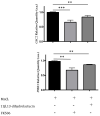Assessing the Intestinal Permeability and Anti-Inflammatory Potential of Sesquiterpene Lactones from Chicory
- PMID: 33228214
- PMCID: PMC7699524
- DOI: 10.3390/nu12113547
Assessing the Intestinal Permeability and Anti-Inflammatory Potential of Sesquiterpene Lactones from Chicory
Abstract
Cichorium intybus L. has recently gained major attention due to large quantities of health-promoting compounds in its roots, such as inulin and sesquiterpene lactones (SLs). Chicory is the main dietary source of SLs, which have underexplored bioactive potential. In this study, we assessed the capacity of SLs to permeate the intestinal barrier to become physiologically available, using in silico predictions and in vitro studies with the well-established cell model of the human intestinal mucosa (differentiated Caco-2 cells). The potential of SLs to modulate inflammatory responses through modulation of the nuclear factor of activated T-cells (NFAT) pathway was also evaluated, using a yeast reporter system. Lactucopicrin was revealed as the most permeable chicory SL in the intestinal barrier model, but it had low anti-inflammatory potential. The SL with the highest anti-inflammatory potential was 11β,13-dihydrolactucin, which inhibited up to 54% of Calcineurin-responsive zinc finger (Crz1) activation, concomitantly with the impairment of the nuclear accumulation of Crz1, the yeast orthologue of human NFAT.
Keywords: 11β,13-dihydrolactucin; 11β,13-dihydrolactucopicrin; NFAT; calcineurin; lactucin; lactucopicrin.
Conflict of interest statement
The authors declare no conflict of interest.
Figures







Similar articles
-
Supercritical CO2 Extraction as a Tool to Isolate Anti-Inflammatory Sesquiterpene Lactones from Cichorium intybus L. Roots.Molecules. 2021 Apr 28;26(9):2583. doi: 10.3390/molecules26092583. Molecules. 2021. PMID: 33925241 Free PMC article.
-
Low Oral Bioavailability and Partial Gut Microbiotic and Phase II Metabolism of Brussels/Witloof Chicory Sesquiterpene Lactones in Healthy Humans.Nutrients. 2020 Nov 28;12(12):3675. doi: 10.3390/nu12123675. Nutrients. 2020. PMID: 33260567 Free PMC article.
-
Unveiling the anti-inflammatory potential of 11β,13-dihydrolactucin for application in inflammatory bowel disease management.Food Funct. 2024 Sep 16;15(18):9254-9271. doi: 10.1039/d4fo01446d. Food Funct. 2024. PMID: 39162124
-
Antiparasitic activity of chicory (Cichorium intybus) and its natural bioactive compounds in livestock: a review.Parasit Vectors. 2018 Aug 22;11(1):475. doi: 10.1186/s13071-018-3012-4. Parasit Vectors. 2018. PMID: 30134991 Free PMC article. Review.
-
Chicory (Cichorium intybus L.) as a food ingredient - Nutritional composition, bioactivity, safety, and health claims: A review.Food Chem. 2021 Jan 30;336:127676. doi: 10.1016/j.foodchem.2020.127676. Epub 2020 Jul 29. Food Chem. 2021. PMID: 32768902 Review.
Cited by
-
Chicory Extracts and Sesquiterpene Lactones Show Potent Activity against Bacterial and Fungal Pathogens.Pharmaceuticals (Basel). 2021 Sep 20;14(9):941. doi: 10.3390/ph14090941. Pharmaceuticals (Basel). 2021. PMID: 34577641 Free PMC article.
-
Discovery of potential mTOR inhibitors from Cichorium intybus to find new candidate drugs targeting the pathological protein related to the breast cancer: an integrated computational approach.Mol Divers. 2023 Jun;27(3):1141-1162. doi: 10.1007/s11030-022-10475-9. Epub 2022 Jun 23. Mol Divers. 2023. PMID: 35737256
-
Enzyme-treated chicory for cosmetics: application assessment and techno-economic analysis.AMB Express. 2022 Dec 6;12(1):152. doi: 10.1186/s13568-022-01494-8. AMB Express. 2022. PMID: 36472772 Free PMC article.
-
Chicory: Understanding the Effects and Effectors of This Functional Food.Nutrients. 2022 Feb 23;14(5):957. doi: 10.3390/nu14050957. Nutrients. 2022. PMID: 35267932 Free PMC article.
-
Environmental and socio-economic impacts of new plant breeding technologies: A case study of root chicory for inulin production.Front Genome Ed. 2022 Oct 6;4:919392. doi: 10.3389/fgeed.2022.919392. eCollection 2022. Front Genome Ed. 2022. PMID: 36275198 Free PMC article.
References
MeSH terms
Substances
Grants and funding
LinkOut - more resources
Full Text Sources
Molecular Biology Databases

